Last Updated on February 20, 2023 by Heather Hart, ACSM EP, CSCS
The following article on running with plantar fasciitis was written by Amy San Filippo, Doctor of Physical Therapy, Exercise Physiologist, UESCA Certified Triathlon Coach, Level II Masters Swim Coach, Level I WOWSA Certified Open Water Swim Coach, Level III ASCA USA Swim Coach.
As a physical therapist I have seen many runners stop dead in their tracks due to plantar fasciitis pain; even in the midst of perfect training when everything has seemingly been going ok.
Plantar fasciitis is one of the most common injuries we treat at our sports medicine clinic. But, just because it’s a common running injury, doesn’t mean it’s not a big deal.
In this post, we’ll cover:
- What is plantar fasciitis?
- What are the symptoms of plantar fasciitis?
- What causes plantar fasciitis in runners?
- 6 ways to treat plantar fasciitis
…and more. Whether you have a current case of plantar fasciitis, or if you’re wondering if that slight ache in sole of the foot might be plantar fasciitis, or you simply want to prevent this painful condition from happening in the first place, this post is for you.
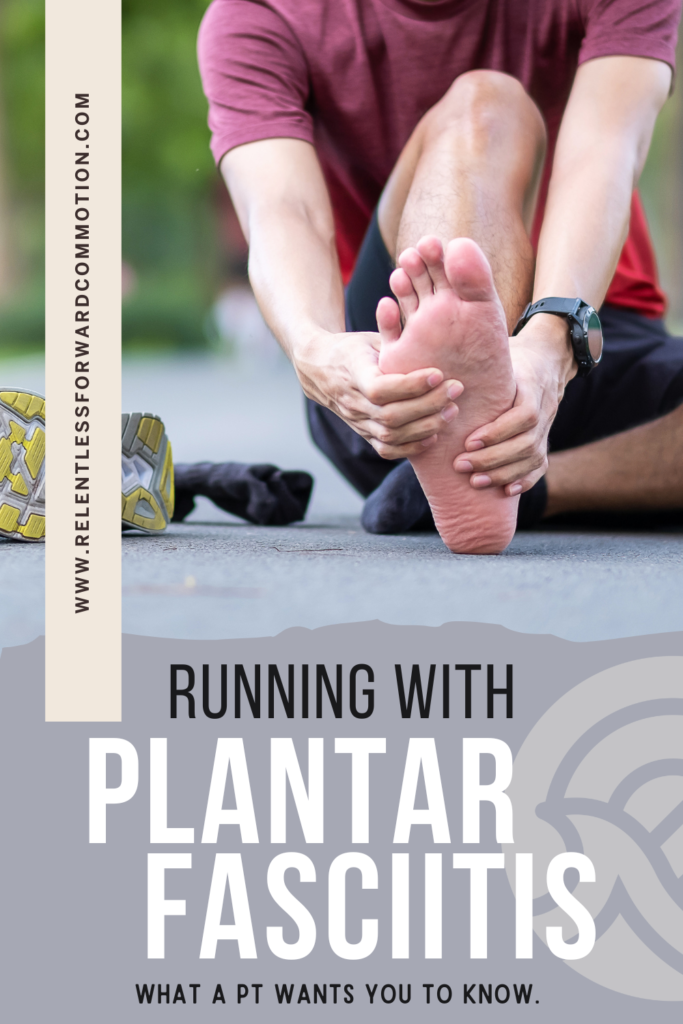
Disclaimer: This article is provided for informational purposes only. If you are dealing with an injury or other health conditions, we recommend you follow up with a qualified medical professional.
What is Plantar Fasciitis?
Plantar fasciitis is an inflammation of the plantar fascia, which is a fibrous structure that runs along the arch or the bottom of the foot. This inflammatory condition of the connective tissue originates at the heel and fans outward toward the base of your toes.
What are the Symptoms of Plantar Fasciitis?
The symptoms of plantar fasciitis include:
- Aching or stabbing pain on the bottom of the foot.
- Pain with the first few steps after getting out of bed or after long periods of time off of your feet
- Pain before or after physical activity (but lessening during activity)
Most patients that come into the clinic complain of arch pain or heel pain. Upon examination, the most repeatable symptom is found by simply applying pressure at or near the medial tubercle of the heel bone. This is where the thick band of fascia originates and it is usually exquisitely tender.
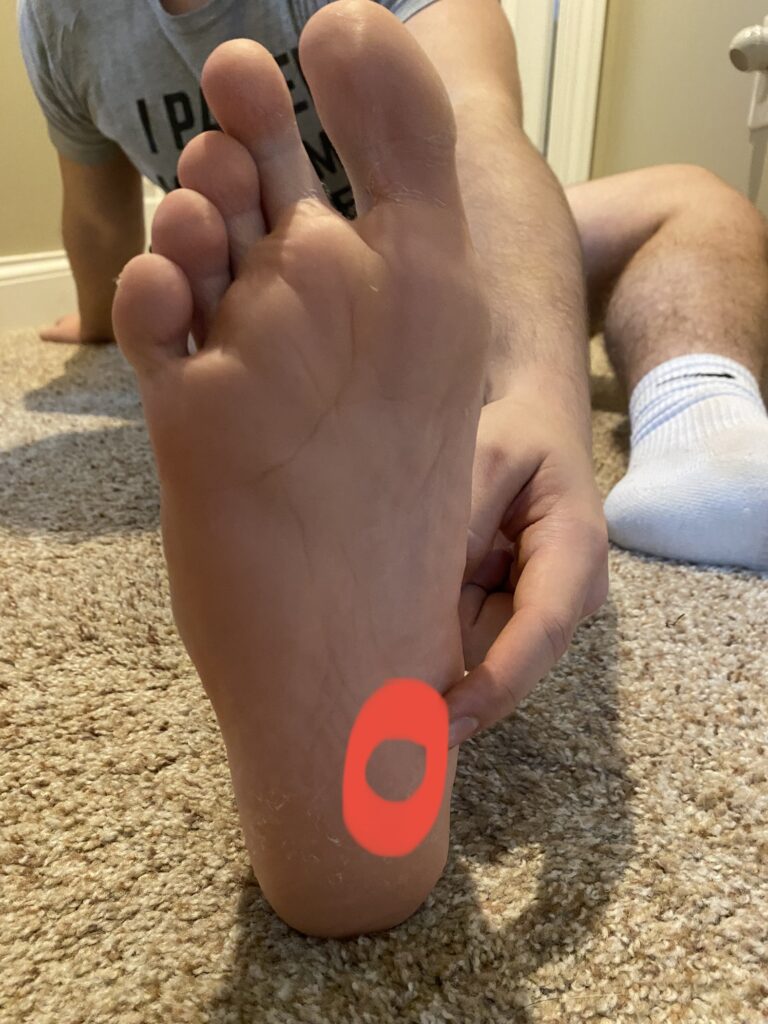
Patients usually report pain that is worse first thing in the morning when taking their first steps out of bed. Pain is also reported if they have been sitting for more than a few minutes and then resume weight bearing and walking.
Symptoms Of Plantar Fasciitis In Runners
In addition to the aforementioned symptoms, most runners report that the first ½ mile to mile of their run is the worst in regards to foot pain. However, after they have loosened up, they are able to continue their run virtually pain free.
How Common Is Plantar Fasciitis In Runners?
Plantar fasciitis is is one of the most common foot injuries in runners, and has been reported to be found in 42% of middle-distance runners and 25% of long-distance runners (Di Caprio et al.)
What Causes Plantar Fasciitis in Runners?
There are numerous causes for plantar fasciitis among runners. Here are just a few of the more common ones:
- Increasing mileage too quickly
- Changing terrain/running surfaces during training when not prepared; ie too much time on the treadmill, too much hill work, a very technical trail, etc.
- Shoe wear during training: such as – changing shoes with proper adaptation (such as switching from a high drop to a zero drop shoe), wearing shoes when they no longer give you proper support, wearing ill-fitting shoes.
- Shoe wear outside of training: such as – lacking proper arch support, high heels that cause tightness in calf muscles, etc.
- Weight gain, as with pregnancy
- Lack of flexibility in lower leg and foot (tight calves or other muscles, etc.)
- Muscle weakness in the foot, ankle, or calf

Can Running in the Wrong Shoes Cause Plantar Fasciitis?
Running in the wrong shoes – such as wearing stability shoes if you do not need them- can possibly cause plantar fasciitis or other potential running injuries.
If your running shoes have too much support along the arch of your foot, this can actually make your plantar fasciitis symptoms worse. The goal of supporting an arch is to help redistribute your body weight over your foot appropriately, thereby helping you absorb shock appropriately through the foot and the entire kinetic chain (foot to pelvis).
When this is done correctly, there are no increased risks for injury.
However, if there is too much support from wearing overly supportive shoes, the position of your ankle will change and can possibly cause you to be in a “supinated” position where your ankle rolls outward slightly. This can cause problems with the ankle itself, and will change how your body attenuates shock.
It is not uncommon for runners to come in with issues like shin splints or knee pain when they are not supporting their arch correctly. Also, this puts the ankle in a position of instability and will increase your chances of rolling your ankle on the trails.
Why Does Plantar Fasciitis Hurt More in the Morning?
When we are at rest, or sleeping overnight, our bodies are busy repairing any damage that was done during activity throughout the day. Think about how you relax into bed and the position that the foot and ankle are typically in.
Usually, the foot and ankle relax into a position called plantar flexion, where the toes are pointed away from the body. This, in effect, shortens the calf muscles, Achilles tendon, and the plantar fascia. This is where the repair is done – in this shortened position.

Then, upon waking, we step down onto the floor and stretch all of those soft tissues and disrupt all of the healing our body has worked so hard to do in that relaxed position. And that is how we start the day – inflamed, and irritated.
So, it makes sense to sleep with the foot and ankle positioned in a more functional way. That way, when we step down in the morning, we are in essentially the same position that we slept in and we do not disrupt the soft tissues.
This is why a night splint, like the Strassberg sock, is one of my go-to’s.
Do Plantar Fasciitis Socks (like the Strassburg sock) actually work?
For some patients, yes, the Strassburg sock does help to relieve plantar fasciitis pain. The Strassberg sock positions the foot and ankle where we want it, in a functional position, and keeps it there until the runner removes it in the morning.
If patients have difficulty sleeping in that position, I simply tell them to put the sock on after their long run, and sit and read with it on for an extended period of time while they rest.
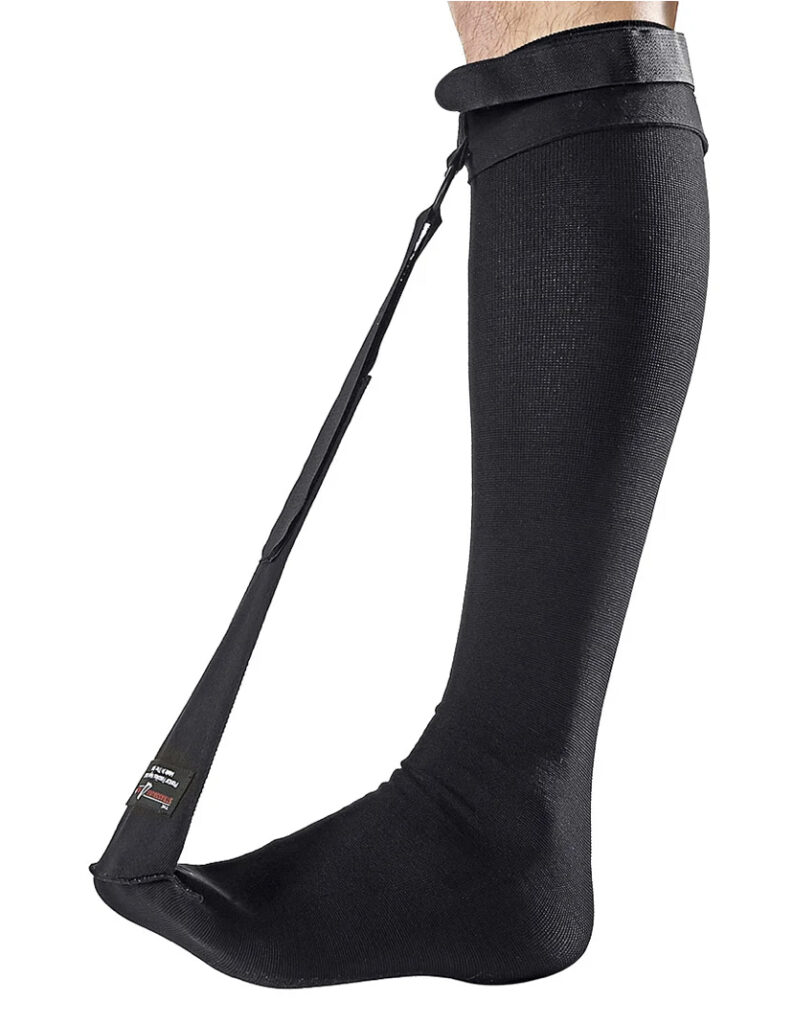
Even if you can’t wear them when sleeping, wearing a Strassburg sock after running with the legs elevated in a chair, or before bed while reading/watching TV may be beneficial.
This position is helpful while the body repairs from every day damage and puts the foot into a functional position so the first step in the morning doesn’t tear up all of the work your body did overnight.
6 Ways Runners Can Treat Plantar Fasciitis
While there is no cookie-cutter way to treat a patient, I have seen some techniques that work quite well in relieving and treating plantar fasciitis for most patients.
1. Visit a Medical Professional
There are a number of plantar fasciitis treatment options that can only be done by a physical therapist in the clinic, like using ultrasound or Graston techniques, or by a physician in a medial setting, such as cortisone injections.
That said, there are plenty of things that runners can do on their own to start feeling better quickly.
2. Control Plantar Fasciitis Symptoms
Next, we need to control the symptoms. Here is where it gets fun! We need to find out what is tight and/or weak, and then we can begin to fix the problem at its source.
One of those things, as mentioned above, is the Strassberg sock. Another is ice massage.
I suggest patients freeze a water bottle so that, after they run or have been on their feet all day, they can roll the frozen water bottle under the affected area for pain relief. It works nicely to calm things down after long periods on their feet using both the ice and some massage at the same time.
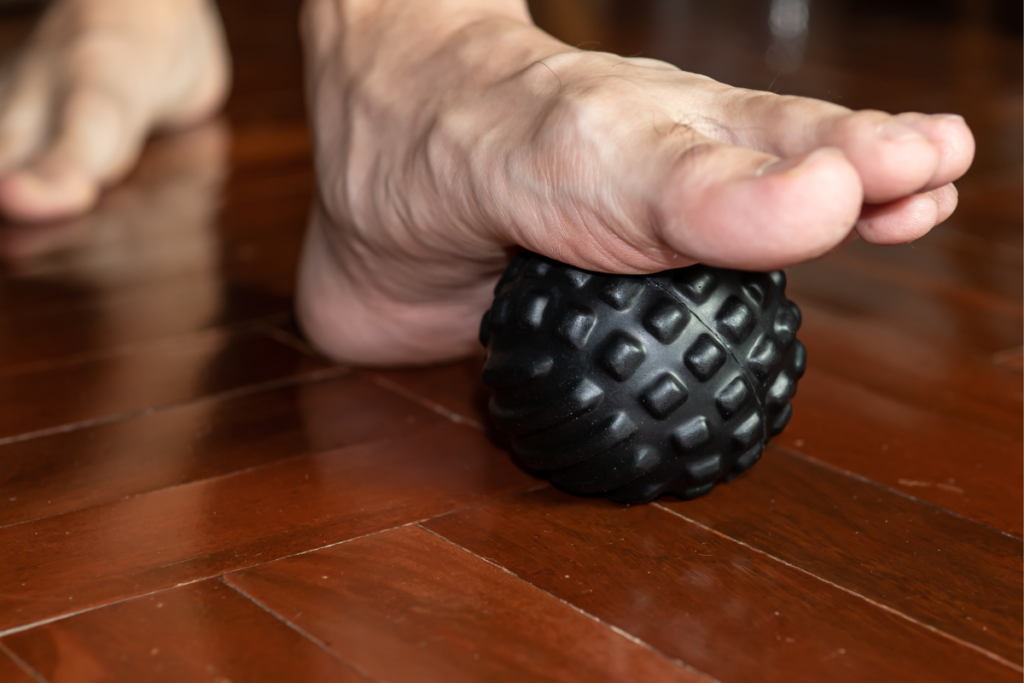
3. Wear & Run in the Right Shoes
Assessing a runner’s shoes is an important step in treating plantar fasciitis. If you haven’t already, head to your local running shop for a foot and gait analysis.
I am lucky enough to work in a clinic that is inside of a running store. So, it’s a short walk out into the store to analyze someone’s foot using a scan, and then suggest proper footwear for them.
I personally like to look at wear patterns on the bottoms of the shoes and talk about shoe wear throughout the day, not just during activity.
4. Stretching
Stretching not only your foot, but your lower legs, can help alleviate pain in the sole of your foot from plantar fasciitis.
Stretching the calf muscles can be very beneficial. I will typically have runners do a calf stretch against the wall with the knee both straight and flexed as pictured.
Also, stretching the arch of the foot (as pictured below) helps with pain relief.

5. Strengthening
Lastly, I recommend strengthening the muscles in the foot, also called the intrinsics. A simple way to strengthen these muscles is to place a towel on the ground and use your toes to pick it up. This is also referred to as towel crunches.
I have always believed that the foot should be strengthened, and that the rest of the kinetic chain should be addressed for tightness and weakness as well. My first instinct is to correct the imbalances and try to use that approach first instead of taping or using orthotics. If conservative treatments don’t work, there’s always Plan B.
6. Taping
For some more severe cases, arch taping with kinesio tape does the trick, along with rest. Taping the arch gives the foot proper support and allows things to calm down.
Check out this video on YouTube to learn how to KT tape plantar fasciitis.
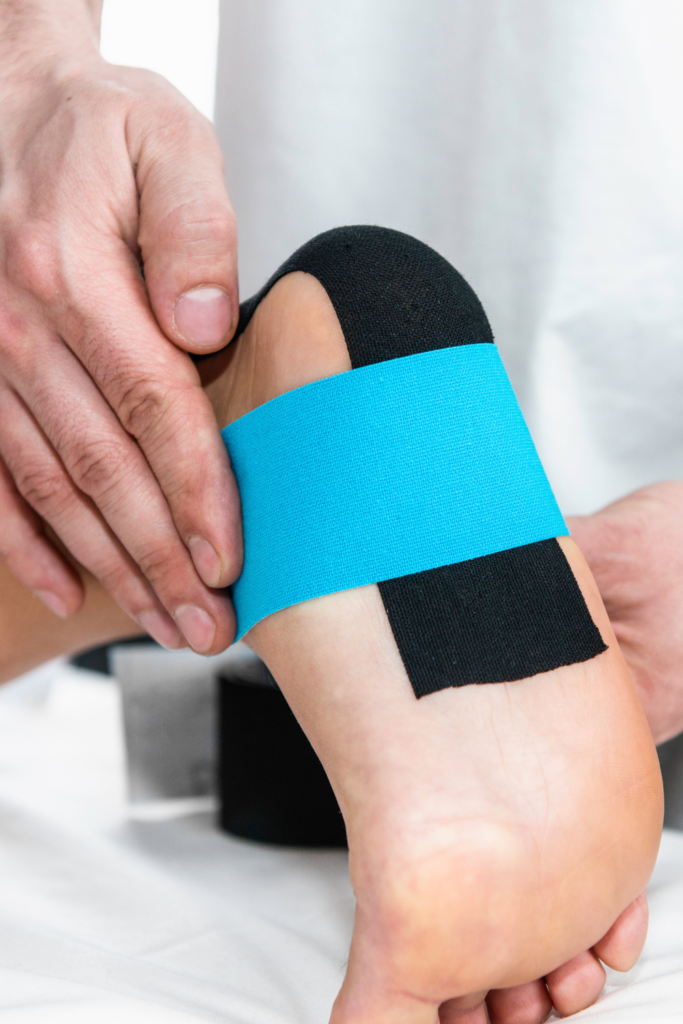
Can I Continue toRun with Plantar Fasciitis?
So, the million dollar question is: Can I still run with plantar fasciitis? The answer is yes, if:
- The pain lessens or goes away during your run
- If you do not change your gait during your run
- If you are performing corrective exercises
- If you do not increase your mileage or intensity of your runs until the issues has resolved.
Our Medical Director has always suggested the following guideline (and I agree 100%): you can continue to run as long as you are not limping, compensating, or changing your running form. If the pain is causing you to change how you’re running, it is in your best interest to stop.
Will running with plantar fasciitis make it worse?
Whether or not running with plantar fasciitis will make the condition worse is something I can’t answer that with a blanket statement. It really depends on the patient.
But if I have to pick yes or no, I would always err on the side of caution and say “yes” you can further aggravate plantar fasciitis by running on it.

I have treated patients that, as soon as they hear they can run through it, they jump right back into their mileage and throw caution to the wind. These are the runners who wind up with big problems that can take them out of the whole season.
So, I always go back to what our medical director says: if the symptoms improve during the run and you aren’t changing your gait, go for it. BUT, after the run, even if you don’t think you need to, perform the ice massage and KEEP DOING YOUR EXERCISES! That is what will kick plantar fasciitis to the curb long term.
Dynamic Warmups for Running with Plantar Fasciitis:
It is also important to perform a dynamic warm up before running your first mile. By moving your body and increasing the blood flow to your soft tissues, you are preparing the body for activity instead of heading out “cold”. Just 5-10 minutes does the trick.
A good example of a dynamic warm up would be 15-20 reps of each of the following:
- Leg swings front to back
- Pendulum swings side to side
- Heel raises / calf raises
- Towel crunches using your toes
- Hip openers
If you prepare your body for the run, run with proper form, and stretch and ice immediately after your run, you can manage your symptoms most of the time.
Stay on task, and keep your symptoms under control, and you will reap benefits.
Tips for Preventing Plantar Fasciitis from Returning
In order to prevent plantar fasciitis from coming back, keep the following tips in mind:
- Maintain strength and mobility (don’t stop doing your exercises, but decrease the frequency of them if you want!)
- Avoid a sudden increase in your running intensity or mileage. Follow a training plan to help ensure a proper and gradual increase in training volume. (Check out our free training programs if you are looking for a place to start!)
- Vary your running surfaces
- Keep track of the mileage on your shoes
Be smart and seek medical advice if your pain is uncontrollable, severe, or persists. Track the mileage on your shoes and replace them every 300-500 miles. Look at the soles of your shoes and make sure there is still traction.
And remember: Happy feet, happy runner!
Resources:
Di Caprio, F., Buda, R., Mosca, M., Calabro’, A., & Giannini, S. (2010). Foot and lower limb diseases in runners: assessment of risk factors. Journal of sports science & medicine, 9(4), 587–596.
Kindred, J., Trubey, C., & Simons, S. M. (2011). Foot injuries in runners. Current sports medicine reports, 10(5), 249–254. https://doi.org/10.1249/JSR.0b013e31822d3ea4
Vasiliadis, A. V., Kazas, C., Tsatlidou, M., Vazakidis, P., & Metaxiotis, D. (2021). Plantar Injuries in Runners: Is There an Association With Weekly Running Volume?. Cureus, 13(8), e17537. https://doi.org/10.7759/cureus.17537
Amy is a Doctor of Physical Therapy, Exercise Physiologist, UESCA Certified Triathlon Coach, Level II Masters Swim Coach, Level I WOWSA Certified Open Water Swim Coach, Level III ASCA USA Swim Coach. Amy is the Owner/Head Coach for Tri and Swim Coaching LLC, Force Aquatics Masters Swim Team, and Head Swim Coach for Tri Columbus. She has been a competitive swimmer for over 40 years, a runner for over 35 years, and a triathlete since 2000. She is the mom of four busy kids, and she and her husband compete in all distances of triathlon and trail running distances from 10k to 50k. Her motto is: If you can dream it, you can do it!


Joe
Thank you for sharing your experience with plantar fasciitis and your tips for running with this condition. As someone who has struggled with foot pain in the past, I know how frustrating it can be to try to stay active while dealing with this type of injury. Your advice on stretching, strengthening, and wearing supportive shoes is very helpful, and I appreciate your emphasis on taking things slow and listening to your body. It’s great to see that you have been able to continue running and enjoying the sport despite your injury. Keep up the good work!